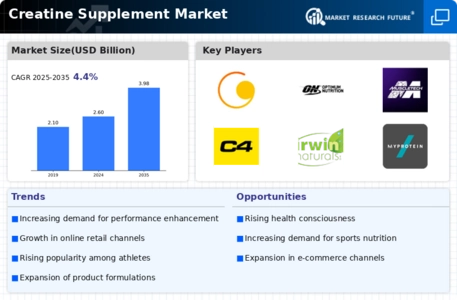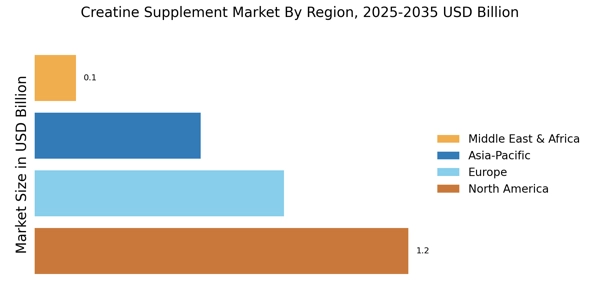Focus on Personalized Nutrition
The trend towards personalized nutrition is gaining traction within the Creatine Supplement Market, as consumers increasingly seek tailored solutions to meet their specific health and fitness goals. Advances in technology, such as DNA testing and mobile health applications, allow individuals to receive customized recommendations based on their unique physiological needs. This shift towards personalization is expected to drive demand for creatine supplements that cater to specific demographics, such as athletes, older adults, or those with particular health concerns. As the market adapts to these evolving consumer preferences, brands that offer personalized creatine solutions may find themselves well-positioned to capture a larger share of the market, thereby influencing the overall dynamics of the Creatine Supplement Market.
Expansion of E-commerce Platforms
The proliferation of e-commerce platforms has transformed the way consumers access products, including those in the Creatine Supplement Market. With the convenience of online shopping, consumers can easily compare products, read reviews, and make informed purchasing decisions. This shift towards digital retailing has been accompanied by a notable increase in online sales of dietary supplements, which are expected to account for a significant portion of the market share. As of 2025, e-commerce is anticipated to represent over 30% of total sales in the supplement sector. This trend suggests that brands in the Creatine Supplement Market must enhance their online presence and marketing strategies to capture the growing number of consumers who prefer shopping online.
Rising Awareness of Health Benefits
There is a growing awareness among consumers regarding the health benefits associated with creatine supplementation, which is positively influencing the Creatine Supplement Market. Research indicates that creatine not only aids in muscle growth and performance but also has potential cognitive benefits, such as improved memory and mental clarity. This multifaceted appeal is attracting a broader audience, including not just athletes but also recreational gym-goers and individuals seeking cognitive enhancement. As educational campaigns and scientific studies continue to highlight these benefits, the market is likely to expand further. The increasing recognition of creatine's versatility may lead to a more diverse consumer base, thereby driving sales in the Creatine Supplement Market.
Increasing Demand for Sports Nutrition
The rising interest in fitness and athletic performance has led to an increasing demand for sports nutrition products, including those in the Creatine Supplement Market. As more individuals engage in regular exercise and competitive sports, the need for effective supplements to enhance performance becomes apparent. According to recent data, the sports nutrition segment is projected to grow at a compound annual growth rate of approximately 8% over the next few years. This growth is likely driven by a greater awareness of the benefits of creatine, which is known to improve strength, muscle mass, and recovery times. Consequently, the Creatine Supplement Market is experiencing a surge in demand as consumers seek products that can support their fitness goals.
Emergence of Innovative Product Formats
The Creatine Supplement Market is witnessing a trend towards innovative product formats that cater to diverse consumer preferences. Traditional powder forms are being complemented by capsules, gummies, and ready-to-drink formulations, making it easier for consumers to incorporate creatine into their daily routines. This diversification is essential in attracting a wider demographic, including those who may be hesitant to use conventional powders. Additionally, the introduction of flavored options and blends with other performance-enhancing ingredients is likely to enhance consumer appeal. As the market evolves, companies that prioritize innovation in product development may gain a competitive edge, thereby contributing to the overall growth of the Creatine Supplement Market.


















Leave a Comment